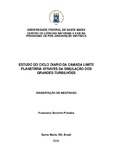| dc.creator | Puhales, Franciano Scremin | |
| dc.date.accessioned | 2017-05-08 | |
| dc.date.available | 2017-05-08 | |
| dc.date.issued | 2008-12-15 | |
| dc.identifier.citation | PUHALES, Franciano Scremin. Study of daily cycle of planetary boundary layer by large eddy simulation. 2008. 179 f. Dissertação (Mestrado em Física) - Universidade Federal de Santa Maria, Santa Maria, 2008. | por |
| dc.identifier.uri | http://repositorio.ufsm.br/handle/1/9193 | |
| dc.description.abstract | The PBL is the region on the troposphere characterized by existence of turbulence (BUSINGER, 1981). Turbulent flow is that when the fluctuations of the variables that describe the flow are amplified in time and space (LANDAU; LIFSHITZ, 1959). The study of the planetary boundary layer (PBL) through the computational fluid dynamics, particularly the large eddie simulation (LES) is an important tool and driven by constant improvement of computing resources. The use of numerical simulations has some advantages over other techniques because it gives a full description of the vertical extent of the PBL. However, it also shows its limitations by simplifications in the equations solved and approximations of numerical methods. The technique employed in the construction of LES models utilizes the volumeavarege to solve the equations of motion for a particle of fluid. With this procedure is expects to solve these equations for large eddies, in which it is believed to be the most turbulent kinetic energy. We solved this scale. Therefore, we solve the scales associated to the large eddies. The rest of the turbulent scales, that is, the smaller scales are approximated by a subfilter or subgrid model. The separation between the scales resolved and subfilter is made by a process of filtering. The width of this filter is directly related to resolution of the grid computing. In this work we establish a comparison between the results obtained from the Moeng s LES model (MOENG, 1984) with experimental data obtained in the PBL. In addition, are accomplished comparisons with results from other models. Futhermore, were generated turbulent statisticals, which describe the flow in approch based on the turbulent statistical theory. To perform this task, were used for initial conditions and forcing the surface to a good weather day at the experimental site of Candiota. The performance of the LES model to reproduce the experimental data was considered satisfactory. However, the model was less effective in simulating the turbulent night. For this period is necessary a higher resolution grid. | eng |
| dc.description.sponsorship | Coordenação de Aperfeiçoamento de Pessoal de Nível Superior | |
| dc.format | application/pdf | por |
| dc.language | por | por |
| dc.publisher | Universidade Federal de Santa Maria | por |
| dc.rights | Acesso Aberto | por |
| dc.subject | Física | por |
| dc.subject | Turbulência atmosférica | por |
| dc.title | Estudo do ciclo diário da camada limite planetária através da simulação dos grandes turbilhões | por |
| dc.title.alternative | Study of daily cycle of planetary boundary layer by large eddy simulation | eng |
| dc.type | Dissertação | por |
| dc.description.resumo | A CLP é a região da troposfera caracterizada pela existência da turbulência (BUSINGER, 1981). Um escoamento turbulento é aquele no qual as flutuações das variáveis que descrevem o escoamento são amplificadas no tempo e no espaço
(LANDAU; LIFSHITZ, 1959). O estudo da camada limite planetária (CLP) através da dinâmica de fluidos computacional,
sobretudo a simulação dos grandes turbilhões (LES), é uma ferramenta bastante empregada e impulsionada pelo constante aprimoramento dos recursos computacionais. O uso de simulações numéricas apresenta algumas vantagens em
relação a outras técnicas pois fornece uma descrição completa da extensão vertical da CLP. No entanto, também apresenta suas limitações através de simplificações
nas equações resolvidas e aproximações dos métodos numéricos. A técnica empregada na construção do modelo LES consiste na utilização de médias de volume para resolver as equações de movimento para uma partícula de fluido. Com isto espera-se resolver estas equações para os grandes turbilhões, nos quais acredita-se estar a maior parte da energia cinética turbulenta. Chamamos esta escala de resolvida. O restante das escalas, ou seja, as menores escalas do escoamento são aproximadas por um modelo de subfiltro ou subgrade. A separação entre as escalas resolvidas e de subfiltro é realizada por um processo de filtragem. A largura deste filtro está diretamente relacionada a resolução da grade computacional. Neste trabalho propõem-se uma comparação entre os resultados obtidos a partir do modelo LES de Moeng (MOENG, 1984) com dados experimentais obtidos na CLP. Além disto, são realizadas comparações com resultados de outros modelos. Adicionalmente, foram geradas estatísticas turbulentas, que descrevem o escoamento
em uma aproximação baseada na teoria estatística da turbulência. Para isso foram utilizadas condições iniciais e forçantes de superfície para um dia de bom tempo do sítio experimental de Candiota. O desempenho do modelo LES em reproduzir os dados experimentais foi considerado satisfatório. Entretanto o modelo se mostrou menos eficaz em simular a
turbulência noturna. Para tal período se faz necessária uma maior resolução de grade. | por |
| dc.contributor.advisor1 | Degrazia, Gervásio Annes | |
| dc.contributor.advisor1Lattes | http://buscatextual.cnpq.br/buscatextual/visualizacv.do?id=K4787248Z6 | por |
| dc.contributor.referee1 | Marques Filho, Edson Pereira | |
| dc.contributor.referee1Lattes | http://buscatextual.cnpq.br/buscatextual/visualizacv.do?id=K4795917D4 | por |
| dc.creator.Lattes | http://buscatextual.cnpq.br/buscatextual/visualizacv.do?id=K4710016J4 | por |
| dc.publisher.country | BR | por |
| dc.publisher.department | Física | por |
| dc.publisher.initials | UFSM | por |
| dc.publisher.program | Programa de Pós-Graduação em Física | por |
| dc.subject.cnpq | CNPQ::CIENCIAS EXATAS E DA TERRA::FISICA | por |


